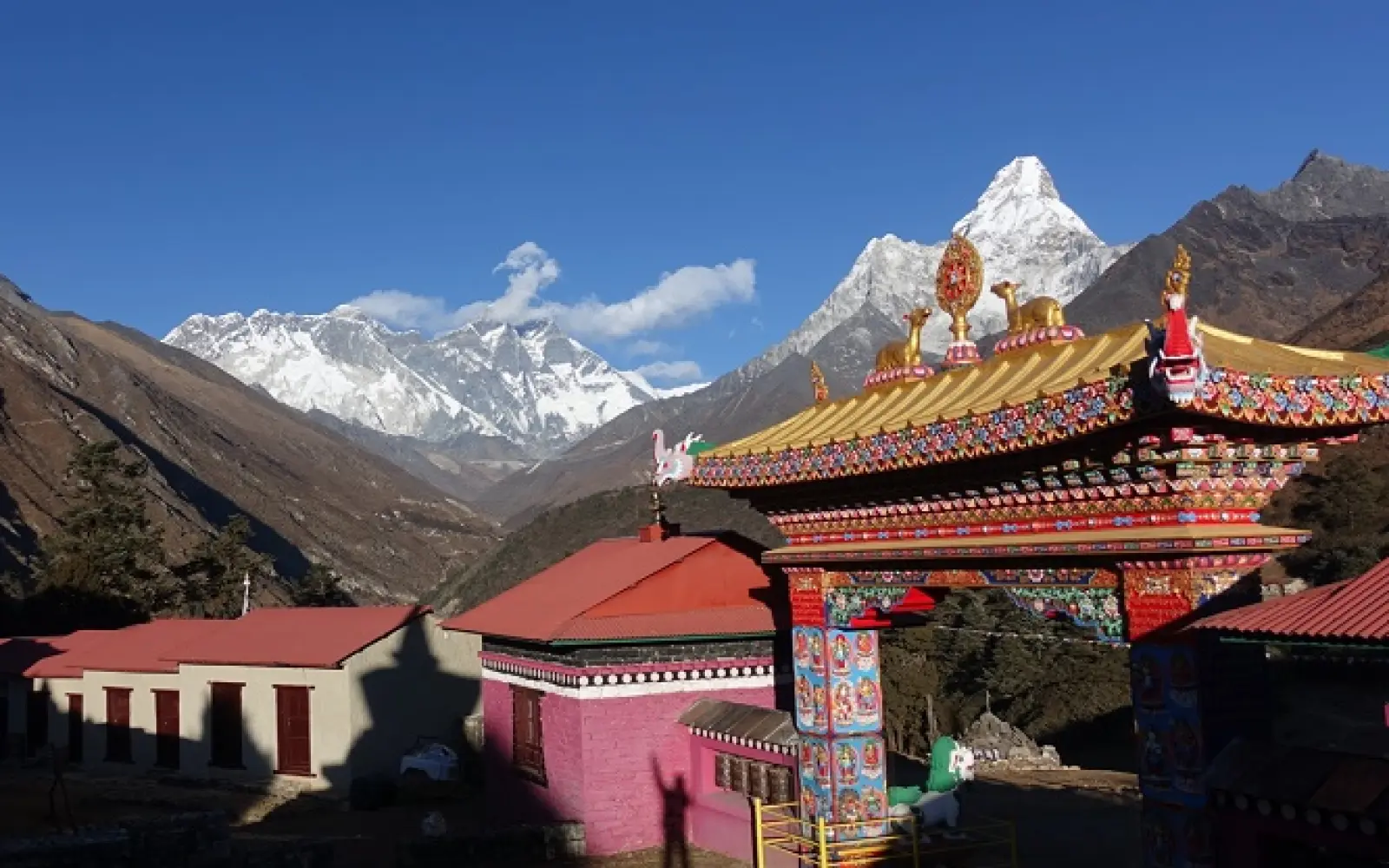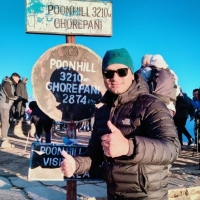


To begin with, Tengboche is a village standing at 3,867 meters above sea level in Nepal. It is famous for the Tengboche Monastery, one of the largest monasteries in the Himalayas. The village lies in the Khumbu region and is a significant resting spot for Everest trekkers. Tengboche offers superb views of Mount Everest (8,848 meters), Ama Dablam (6,812 meters), and other magnificent peaks.
Further, Tengboche is a religious center of Sherpa culture and Buddhism. The monastery is a place of pilgrimage for tourists and visitors from around the globe. People visit to observe Buddhist rituals, particularly the Mani Rimdu festival held annually. The festival comprises vibrant dances and prayers that represent blessings for the region.
Likewise, Tengboche is also an important acclimatization stop along the Everest Base Camp trekking route. Trekkers usually arrive here following a hike from Namche Bazaar. The settlement helps trekkers acclimatize to high elevation, reducing the risk of illness. Effective acclimatization increases prospects for a successful trek.
Additionally, Tengboche contains simple lodges and tea houses for lodging. The village is serene and culturally vibrant amidst a spectacular mountain setting. Its natural beauty and religious significance attract many tourists every year.
In conclusion, Tengboche is a memorable destination that combines culture, nature, and trekking value. It is a stopover that one cannot avoid on the Everest trail.
First, Tengboche is located in Nepal's Solukhumbu district along EBC Trek Route. It sits at 3,867 meters high on a ridge overlooking the Dudh Koshi River valley. The village lies in Sagarmatha National Park, a UNESCO World Heritage Site. The location offers trekkers stunning vistas of Himalayan peaks.
Furthermore, Tengboche is surrounded by mythologically magical mountains like Mount Everest (8,848 meters), Lhotse (8,516 meters), and Ama Dablam (6,812 meters). These towering giants create a dramatic background for the trekkers. The village itself is surrounded by rhododendron and pine forests, which further enhance the natural beauty.
Similarly, the location of Tengboche on the Everest trekking trail makes it a necessary halt. It lies between Namche Bazaar (3,440 meters) and Pangboche (3,985 meters) villages. The setting on the ridge top offers panoramic glimpses of deep valleys and snow-capped peaks. Nature adds colors to the landscape with the change of seasons.
Also, the geography around Tengboche is rugged but manageable. The village sits atop a natural ledge above the Dudh Koshi River. Such topography makes it a perfect place to stop and acclimatize. Trekkers enjoy clean mountain air and breathtaking scenery here.
In short, Tengboche's geography and landscape offer beauty and trekking convenience. Its high altitude and surrounding mountains make it a place worth remembering.
To begin with, Tengboche is accessible only on foot since there are no roads or vehicles linking this mountain village. Trekkers normally start their journey from Lukla Airport, which is at an altitude of 2,860 meters above sea level. It takes five or six days of trekking from Lukla to reach Tengboche.
Furthermore, the trekking path to Tengboche passes through Namche Bazaar (3,440 meters), the main Sherpa village in the region. It typically takes five to six hours from Namche to Tengboche. The path rises steadily through rhododendron forests and rocky landscape. Weather and elevation can affect the travel time.
Likewise, trekkers take the Everest Base Camp trail, passing by nearby villages like Pangboche. The trail is well-worn and frequently traveled by trekkers. Helicopter flights to Tengboche are extremely rare and are basically for emergencies or special permits.
Besides, the journey to Tengboche requires sound physical condition and proper acclimatization. The inaccessibility by road keeps Tengboche far and pristine. This inaccessibility attracts trekkers who seek authentic Himalayan experiences.
In sum, Tengboche's accessibility is purely based on trekking. Its remoteness provides natural beauty and cultural richness. Good planning and physical fitness are necessary to reach this special mountain village.
Beginning with, Tengboche boasts basic but sufficient facilities for trekkers. At 3,867 meters above sea level, it's a remote place. But there are several teahouses that offer hot meals and lodging. Basic rooms provide twin beds and wooden walls. You will be provided with a blanket, but sleeping bags are necessary.
Also, there is dal bhat, noodles, soup, and tea for meals. There are dining hall stoves for heating. For breakfast, there is porridge, toast, or pancakes. Food prices increase with altitude due to transport costs. All the ingredients are carried by porters or animals.
In the same way, solar panels provide limited electricity in Tengboche in lodges. Electronic equipment requires an extra charge for charging. Charging is not feasible in cloudy weather. Mobile signals are weak but sometimes available. Wi-Fi is typically not accessible at this altitude.
Moreover, there are solar-heated showers at Tengboche at an extra cost. Water is frozen in winter. Toilets are mostly shared and outside the rooms. Bring your own toilet paper and wet wipes. Some teahouses sell basic hygiene items.
Furthermore, a bakery is also available near the Tengboche monastery in Tengboche. It sells fresh bread, cakes, and coffee. Trekkers use it as a place to gather for relief. A basic health post handles minor medical needs. Oxygen is not found at this stage.
In short, amenities at Tengboche are simple but adequate. Trekkers may prepare accordingly.
Primarily, Tengboche is famous for its scenic and spiritual beauty. It is situated at 3,867 meters. The major attraction is the Tengboche Monastery. It is the largest monastery in the Khumbu region. It is a spiritual center for Sherpas who live locally.
Also, the Tengboche monastery contains colorful rituals and chants. The Mani Rimdu Festival of October is popular. During the festival, monks perform sacred dances. Trekkers achieve deep Buddhist culture. The monastery contains peaceful views and silent prayer time.
Likewise, the surrounding mountains around Tengboche add beauty. You can see Mt. Everest (8,848m), Lhotse (8,516m), and Ama Dablam (6,812m). Sunrise and sunset are mesmerizing. Photographers like to capture these Himalayan giants.
Moreover, Tengboche offers panoramic trails and a serene ambiance. There are mani stones, prayer flags, and chortens. They enrich the village culturally. Yak caravans and prayer wheels provide trekking with a different atmosphere.
Furthermore, trekkers often visit the nearby Eco-Centre at Tengboche. It teaches about conservation and local culture. There is a bakery that is famous for appe pie and coffee. Many stop here for rest and refreshment.
In total, Tengboche provides natural beauty and spirituality. It is a must-visit on the Everest trail.
Primarily, a trip to Tengboche Monastery is the most ideal thing to do. It stands at 3,867 meters. Chants by monks in the morning and evening are held. Trekkers go there for prayer sessions for peace. The calm atmosphere adds to it.
Also, photography is another popular activity in Tengboche. You can capture Mt. Everest (8,848m), Lhotse (8,516m), and Ama Dablam (6,812m). Sunrise and sunset are especially spectacular. The majority of tourists stop to capture classic photos. The mountainous landscape and light are perfect.
Likewise, nature lovers enjoy short treks around Tengboche. The trail from Tengboche to Debuche is serene and scenic. It snakes through dense forests of rhododendron. Himalayan wildlife and birds can be spotted. These treks also offer great mountain views.
Moreover, cultural experience is rewarding in Tengboche. You can observe Sherpa traditions and Buddhist rituals. Spinning wheels, prayer flags, and mani stones are everywhere. These symbols are indicative of deep-seated spiritual beliefs.
Besides, tea house leisure is enjoyable in Tengboche. Trekkers often take tea and enjoy the mountain views. The local bakery has freshly baked apple pie. It is a nice reward after a long day. Many use this time to journal or reflect.
Overall, Tengboche has spiritual and scenic activities. It is a peaceful break in the middle of the trek.
Firstly, Tengboche is at an altitude of 3,867 meters above sea level. Altitude sickness may begin here. So, trekkers must rest properly. No alcohol and water intake are musts. Most consume plenty of water to relieve the discomfort.
Secondly, proper acclimatization prevents severe health problems. Trekkers typically spend another night in Tengboche. This enables the body to adjust slowly. Guides monitor symptoms like headaches and dizziness. If symptoms worsen, the only option is to go down.
Likewise, the cold weather demands layered clothing during your stay in Tengboche. Temperatures drop quickly after sunset. Windproof jackets and gloves are essential. Warm socks prevent frostbite. Proper gear ensures safety during chilly nights.
In addition, personal hygiene should not be ignored while staying in Tengboche. Use hand sanitizers before every meal. Water should be boiled or purified. Avoid uncooked food to prevent stomach issues. Clean lodges offer better hygiene standards. Staying cautious reduces infection risks.
Additionally, follow local safety rules in the vicinity of the Tengboche monastery. Follow notices and instructions during ceremonies. Be quiet during prayers. Do not disturb animals and monks. Accidents mostly happen due to distractions.
In summary, safety and health in Tengboche is quite crucial. Proper acclimatization, warm clothing, and hygiene help a lot. Adhering to simple rules makes one's trip to this important trail stop pleasant.
To begin with, Tengboche (3,867 m) has its limited but essential accommodation. Most of the trekkers are housed in tea houses. The lodges have basic rooms and local cuisine. The beds are shared twin with warm blankets. However, the rooms become cold at night.
Moreover, most tea houses in Tengboche use solar or gas heaters. Dining areas are warmer than bedrooms. Hot showers are available but cost extra. Toilets are mostly shared and simple. Cleanliness depends on season and crowd size.
Likewise, Tengboche has fewer lodges than nearby villages. Trekkers should arrive early to get rooms. During peak seasons, rooms fill fast. Guides often pre-book during autumn or spring. Early booking reduces last-minute stress.
In addition, electricity is limited in Tengboche and there is a charging facility. Phones can be charged for a small fee. Internet is slow and sporadic. Wi-Fi service is provided in most tea houses for a charge. Connection may not function during adverse weather.
Besides, being near the Tengboche Monastery gives unique tranquility. Monks chant morning prayers every day. The setting is serene and spiritual. Ama Dablam (6,812 m) and Everest (8,848 m) vistas are awe-inspiring. Sunrise and sunset vistas are stunning.
Overall, Tengboche lodges are basic but memorable. Early arrival, warm clothing, and adaptability make stays easier and more comfortable.

